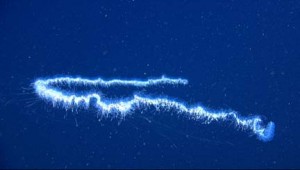Most of us are familiar with the Portuguese Man o’ War – a plastic bag-looking animal that can deliver a nasty sting. Although Portuguese Man o’ Wars somewhat resemble “true jellyfish”, they are not; they belong to a class within Cnidaria known as Hydrozoa. More specifically, Portuguese Man o’ Wars belong to an order called Siphonophorae, which is the focal point of this article.
Siphonophores are enigmatic animals that have boggled scientists since their discovery. These strange creatures exist in the form of free-floating colonies. Siphonophore colonies are composed of many individuals. Individuals vary in function; some sting, while others reproduce, or carry out one of several other vital functions.
As if Siphonophores weren’t interesting enough, Praya Dubia – an abyssal species, is roughly 50m long, making it one of the longest animals on the planet. This fascinating species uses bioluminescence to attract its prey.
So what’s the significance of this strange taxon – Siphonophorae? Because each Siphonophore has a specialized function and is dependent on the other members of its colony much like the cells of a complex multicellular organism are dependent on one another, many scientists believe that understanding Siphonophore evolution may shed light upon the origin of complex multicellular organisms.











0 Comments